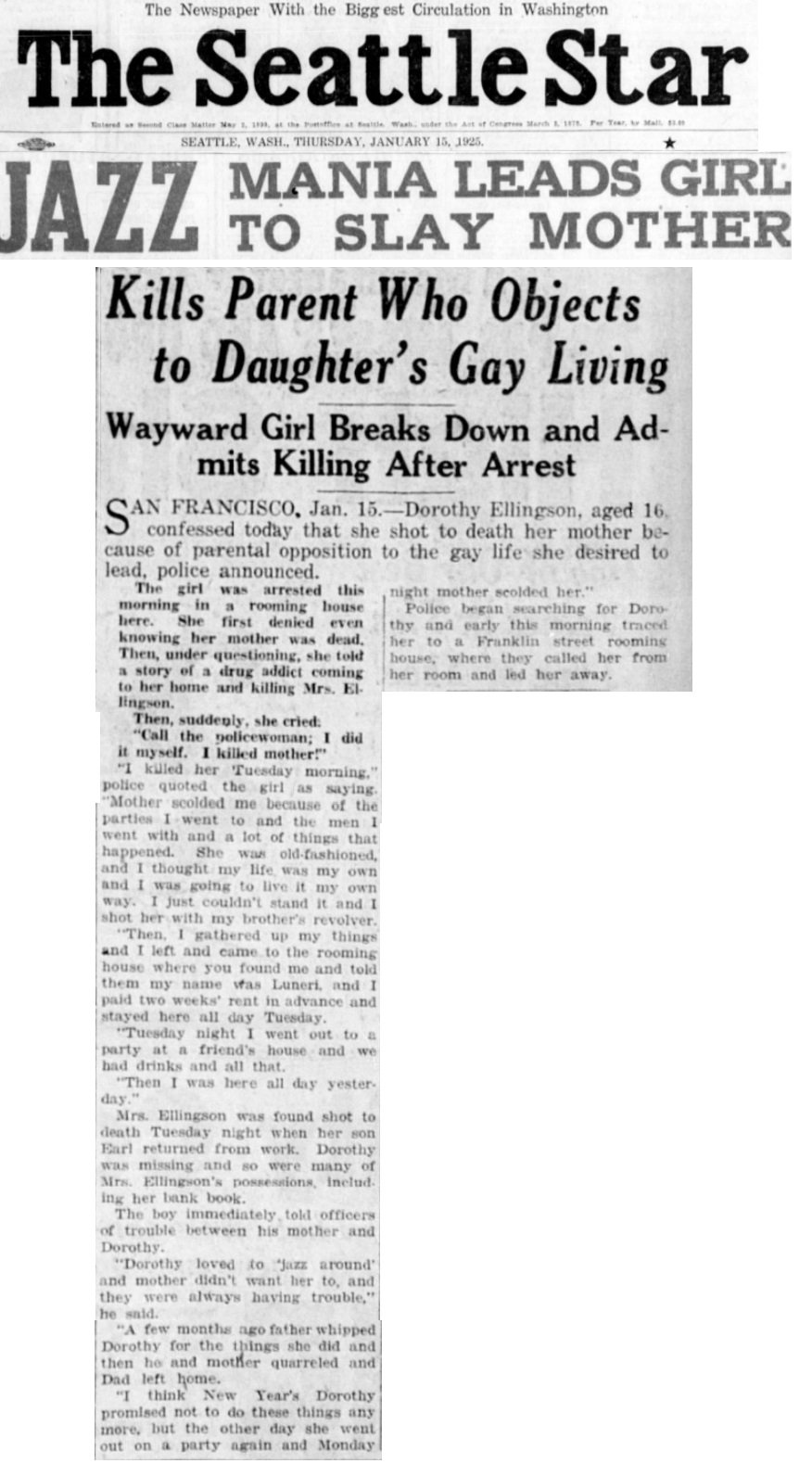Ripped from the front page of the Seattle Star, January 15th, 1925…

4 thoughts on “Scandalous Jazz Lifestyle Leads To Cold-Blooded Murder”
Leave a Reply Cancel reply
Some comments may be held for moderation. (New users)
This site uses Akismet to reduce spam. Learn how your comment data is processed.



That’s too bad that they’re having such a difficult time in today’s world! For centuries the newspapers had no competition. Then about 1920 came radio, 1948, television and recently the internet which has completely blown away the need for a daily paper. I still savor the daily papers with their news and investigative articles.
Today, Seattle can barely support 1 newspaper.
A very interesting article! On another note, Carol Channing the great Broadway actress was born in Seattle in 1921. At the time of her birth her father worked for the Seattle Star. In those days Seattle had three daily papers.
The Jazzmania Murder
In 1925, 16-year-old Dorothy Ellingson shot her mother, created a new disease and inspired world literature.
The Crime
Dorothy lived at 256 Third Ave. in the Inner Richmond, with her father, a tailor, her mother and an older brother. She was a tall girl with flaming red hair and a temperament to match.
“There is something in my heart that makes me hate rules and regular hours. I like to do things when I feel like doing them or I don’t want to do them at all,” said Dorothy, after her arrest.
From the age of 14, Dorothy cut school during the day and snuck out to jazz clubs at night. Her ticket in was a fake ID showing her age as 19.
For months her mother, Anna, tried to keep Dorothy home at night. Finally, on Jan. 13, 1925, Anna threatened to send her daughter back to reform school if she went out dancing that night. Furious, Dorothy found her brother’s gun and shot her mother in the back. Then she took $45, hurriedly packed a suitcase, went to the party and danced the night away.
Her brother discovered the body and called police. The next day the murder was splashed across the headlines and a huge girl hunt began. The case was a nationwide sensation.
“Not in the history of California crime have I found a case where a daughter killed her mother,” said District Attorney Mathew Brady. “I know of no case where a minor has been guilty of this crime.”
It was the heyday of Front Page journalism and William Randolph Hearst’s San Francisco Examiner, which had close ties with the police department, led the pack. The Examiner printed pages from Dorothy’s diary, which revealed frequent trips to the New Shanghai Cafe in Chinatown and her crowd of girlfriends and jazz musicians.
“I went to Joe’s party and met an amazing musician. He knows how to use all of his instruments,” was one of the entries. The press called her the red-headed, bobbed-hair “jazzmania” addict, “soon shortened to “jazzmaniac.”
Dorothy was arrested the next day. This case was an international sensation and dominated the news for months. From Paris, F. Scott Fitzgerald followed the case closely and Dorothy’s story became the inspiration for the first draft of his book, “Tender is the Night.”
The Explanation
“The trouble is he’s crazy,
The trouble is he drinks,
The trouble is he’s lazy,
The trouble is he stinks,”
— “Gee Officer Krupke,” from “West Side Story”
There was no shortage of explanations for Dorothy’s actions.
“She is the product of her environment,” said UC psychologist Olga Bridgman.
“Sound religious training should take the place of dancehalls,” said the Federation of Women’s Clubs.
The nation’s Episcopal bishops claimed that jazz-induced madness was responsible for rising rates of divorce, suicide and crime among young people. “Jazz goes back to the African jungle and its effect is to make you … want to go on all-fours and whisk your tail around a tree,” asserted an Episcopal minister.
The Examiner scored another scoop, getting a three-part confession written by Dorothy Ellingson herself, entitled “Gun Wielder Bares Secret of Jazz Soul.” Next to this article was one by their star journalist Annie Laurie, entitled “Dorothy Ellingson Egoist Who Thinks Only about Herself.”
At first the jazzmania explanation held sway. Against Dorothy’s strong objections a jury ruled 11-1 that she had an irresistible impulse and was insane. Dorothy fainted after the verdict was read. She was sent to Napa State Hospital, but after 30 days the hospital’s psychiatrists declared her to be sane and sent her back.
The Trial
During the trial a new Dorothy appeared. She fainted numerous times, screamed at both the prosecuting attorney and her own lawyers. At other times she became catatonic and had to be carried from the courtroom.
Dorothy’s lawyers wisely did not put her on the stand.
In the end she was convicted of manslaughter and sentenced to one to 10 years. She was released in 1932 and tried to slip into obscurity. But this was not to be.
She was arrested in 1933, under the name of Dorothy Jentoff, for stealing $600 worth of cash, clothes and jewelry from her roommate. In 1955, as Diane Stafford, she was arrested for stealing $2,000 worth of cash, clothes and jewelry from a former employer. She was lodged in the same jail as her 17-year-old son, who had been arrested for burglary. She died on Sept. 16, 1968 at the age of 59.
Forty-three years earlier, on the floor next to her mother’s body, was this verse:
Let the old life be covered by the new
The old past so full of bad mistakes
Let it be wholly hidden by the new
By deeds as white as silent flakes
(Paul Drexler is a crime historian and director of Crooks Tour of San Francisco, http://www.crookstour.com.)